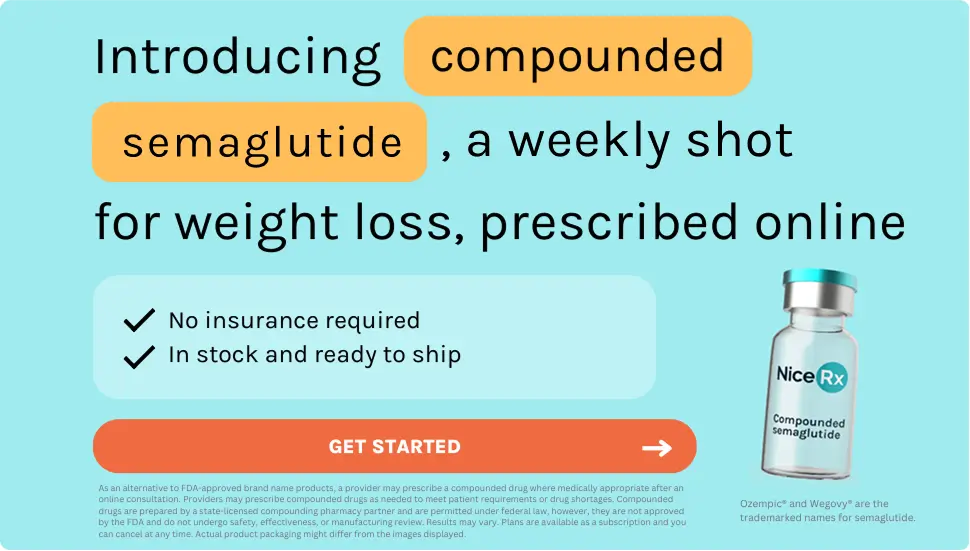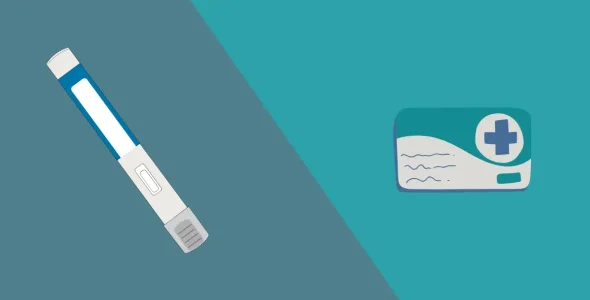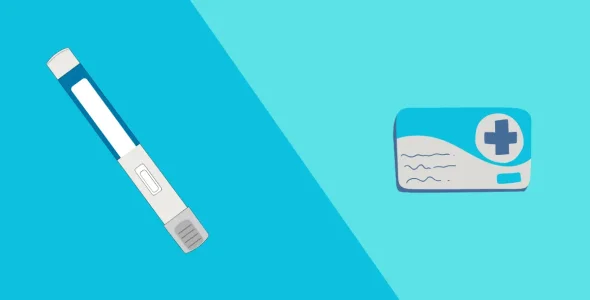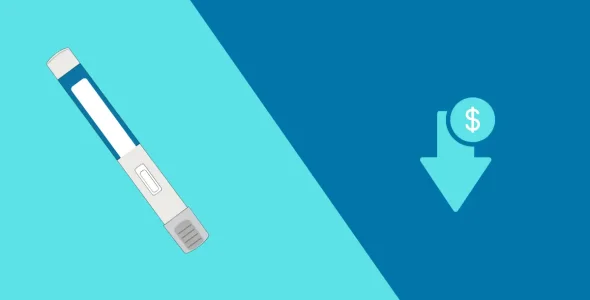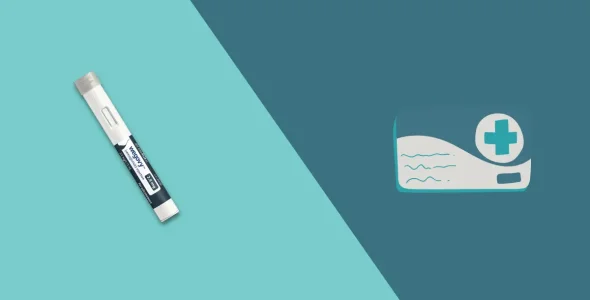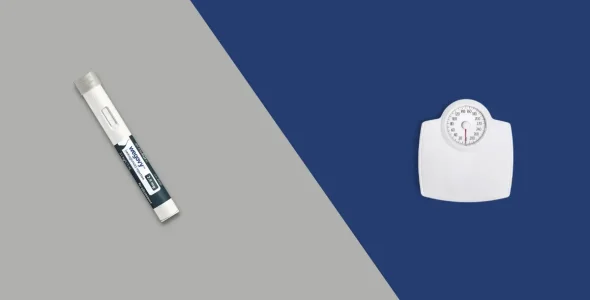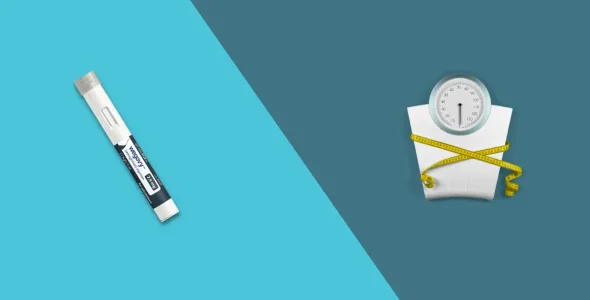What is Wegovy? Is this weight loss medication right for you?
Wegovy isn’t just ‘Ozempic for weight loss’, it’s a higher-dose game-changer with unique benefits and risks. Learn the truth about the most talked-about weight loss drug.
Key highlights
- Wegovy (semaglutide) is a popular and effective GLP-1 receptor agonist, manufactured by Novo Nordisk, used for weight loss in overweight or obese individuals.
- The most common side effects are gastrointestinal-related, including nausea, vomiting, and diarrhea.
- There are several ways to save money on Wegovy. If you qualify, the drug manufacturer offers a savings card that can lower the cost of your prescription.
- The manufacturer offers all doses of Wegovy for $499/month without insurance through NovoCare Pharmacy.
- With the right support and monitoring, Wegovy can offer significant health benefits, helping with weight loss and improving overall well-being.
The World Health Organization (WHO) reported that, globally, 16% of adults aged 18 years and older were obese in 2022. The prevalence of obesity worldwide more than doubled between 1990 and 2022. This growing epidemic urgently requires effective, long-term weight management solutions.
Wegovy (semaglutide) is an FDA-approved weekly injectable weight loss medication. The active ingredient, semaglutide, was approved by the U.S. Food and Drug Administration (FDA) in 2021 for chronic weight management in adults and children 12 and older with obesity and for adults who are overweight with one or more weight-related health conditions, like type 2 diabetes, high cholesterol, or high blood pressure.
In addition to weight loss, Wegovy is approved to lower the risk of serious heart problems like heart attacks and stroke in obese or overweight adults with heart disease.
What is Wegovy? Learn about this FDA-approved weight loss injection, how it works, who qualifies, potential side effects, the cost with and without insurance, and savings tips.
What is Wegovy?
Wegovy was approved by the FDA for chronic weight management in adults with obesity and overweight with at least one weight-related condition, such as high blood pressure, type 2 diabetes, or high cholesterol. It was also approved in 2024 for reducing the risk of serious heart problems in adults with obesity or overweight.
Semaglutide belongs to a class of drugs called glucagon-like peptide-1 (GLP-1) receptor agonists known for their dual benefits: helping to control blood sugar levels in adults with type 2 diabetes and supporting weight loss in people with or without diabetes when used in combination with diet and increased physical activity.
Wegovy and Ozempic contain the active ingredient semaglutide, a medication that helps with blood sugar control and weight loss.
Ozempic is FDA-approved for type 2 diabetes and reduces the risk of serious heart problems, like heart attack, stroke, and death, in adults with type 2 diabetes and heart disease.
Although Ozempic isn’t FDA-approved for weight loss, a healthcare provider may prescribe it off-label to help with weight management.
Ozempic can help protect your kidneys. It is approved to lower the risk of kidney problems in people with type 2 diabetes and kidney disease, but Wegovy doesn’t have this approval.
The key difference between Wegovy and Ozempic is that Wegovy is approved by the FDA for weight loss and comes in a higher dose (up to 2.4 mg). Ozempic is approved for type 2 diabetes and the highest dosage strength is 2.0 mg.
How does Wegovy work for weight loss? The science explained
Wegovy can lead to significant weight loss in people with excess weight and obesity when used with lifestyle changes.
In a 68-week clinical trial, participants on Wegovy lost an average of 14.9% body weight compared to 2.4% in the placebo group.
In another trial involving individuals with cardiovascular disease and obesity but without diabetes, semaglutide (2.4 mg) reduced the progression to diabetes by 5.4% compared to placebo over approximately 3 years.
Semaglutide works by mimicking the GLP-1 receptor, a natural hormone that releases insulin, reduces glucagon and controls appetite, so you eat less. Together, these effects make it easier to lose weight when used with a healthy diet and exercise.
Semaglutide lowers blood sugar by reducing glucagon production, a hormone produced by the pancreas that tells the liver to release stored sugar into the blood, which raises blood sugar levels.
By suppressing glucagon, semaglutide prevents the liver from releasing too much sugar and keeps blood sugar more stable after eating.
This helps with blood sugar control and weight loss by stopping the body from storing excess sugar as fat, creating a better environment for burning fat and losing weight.
Semaglutide helps with weight loss by slowing down how fast food moves through the stomach and into the intestine, also known as gastric emptying. This means you feel full and less hungry for longer, and eat less or snack less between meals.
Semaglutide works by targeting the GLP-1 receptors in the brain to reduce food cravings and increase fullness. By targeting these brain signals, semaglutide controls hunger and satiety.
This makes you less hungry and more full after eating, so you eat less and are less likely to give in to food cravings, which can support weight loss.
Semaglutide lowers calorie intake by making you feel full for longer and reduces your food intake. By acting on the brain to increase satiety and slow down gastric emptying, it controls your appetite, so you eat fewer calories.
Who is Wegovy for? Eligibility criteria
The FDA has approved Wegovy for chronic weight management in adults with:
- Obesity: body mass index (BMI) of 30 or higher, or;
- Overweight: BMI of 27 or higher with at least one weight-related health condition, like type 2 diabetes, high blood pressure, or high cholesterol.
The FDA has also approved Wegovy for adolescents aged 12 years and older who have obesity, defined as:
- a BMI at or above the 95th percentile for age and sex, based on CDC growth charts
- Must weigh at least 60 kg (132 lbs)
- Administered as a once-weekly subcutaneous injection
- Must be used in conjunction with a reduced-calorie diet and increased physical activity
- If an adolescent does not achieve at least a 5% reduction in BMI after 12 weeks on the 2.4 mg or maximum tolerated dose, treatment should be discontinued and re-evaluated
In March 2024, the FDA approved Wegovy to reduce the risk of cardiovascular death, stroke and heart attack in adults with cardiovascular disease and either obesity or overweight.
Additional considerations:
- Wegovy is not approved for use in children under 12 years of age.
- It is not recommended to coadminister Wegovy with other semaglutide-containing products or other GLP-1 receptor agonists.
Wegovy dosage and administration
Wegovy is available in five different pre-filled, single-dose syringes, including 0.25 mg, 0.5 mg, 1.0 mg, 1.7 mg, and 2.4 mg. Each pen contains one dose, so you’ll need four pens for a 30-day supply.
Healthcare professionals usually start patients at 0.25 mg once weekly for 4 weeks, and then the dose is gradually increased every 4 weeks until the maximum dose of 2.4 mg once a week is reached.
Wegovy starting dose and frequency
| Week | Dose | Frequency |
|---|---|---|
| Weeks 1–4 | 0.25 mg | Once weekly |
| Weeks 5–8 | 0.5 mg | Once weekly |
| Weeks 9–12 | 1 mg | Once weekly |
| Weeks 13–16 | 1.7 mg | Once weekly |
| Week 17+ | 2.4 mg (maximum dose) | Once weekly |
Starting dose
The starting dose of Wegovy is 0.25 mg weekly subcutaneous injection. This low dose is used for the first 4 weeks to help the body adjust to the medication and reduce the risk of gastrointestinal side effects like nausea or vomiting.
It is important to note that the 0.25 mg dose is not intended for weight loss but serves as a preparatory step before gradually increasing to higher, therapeutic doses in the following months.
Titration schedule
The treatment with Wegovy should begin with a starting dose of 0.25 mg, administered once weekly. The dose should be increased every 4 weeks, with the next step being 0.5 mg, followed by 1.0 mg, and then 1.7 mg.
By the fifth month, the patient should reach the full maintenance dose of 2.4 mg weekly, provided they tolerate it. After achieving the full dose, the patient should maintain the 2.4 mg dose weekly for long-term weight management.
If the full dose is not tolerated, the titration process can be paused, or the patient may continue with the highest tolerable dose as needed.
Wegovy titration & maintenance dosage schedule
| Month | Dose (mg) | Notes |
|---|---|---|
| Month 1 | 0.25 mg | Starting dose – Weeks 1–4 |
| Month 2 | 0.5 mg | Increase to 0.5 mg – Weeks 5–8 |
| Month 3 | 1.0 mg | Increase to 1.0 mg – Weeks 9–12 |
| Month 4 | 1.7 mg | Increase to 1.7 mg – Weeks 13–16 |
| Month 5+ | 2.4 mg | Maintenance dose – Week 17 onwards |
Maintenance dose
The maintenance dose of Wegovy is 2.4 mg once weekly, administered by subcutaneous injection. This dose is typically reached by the fifth month of treatment, following a gradual 4-week titration schedule through lower doses.
Once the maintenance dose is achieved, it should be continued weekly for ongoing weight management. The 2.4 mg dose is the maximum FDA-approved dose and is intended to support long-term weight loss when combined with a reduced-calorie diet and increased physical activity. If the full dose is not well tolerated, patients may remain on the highest dose they can tolerate.
Maximum dose
The maximum approved dose of Wegovy is 2.4 mg once weekly. This dose is reached after a structured 16-week titration period, starting at 0.25 mg and increasing every 4 weeks until the maintenance dose is achieved.
Once the 2.4 mg dose is reached, it should be maintained weekly, provided the patient tolerates it well. If the 2.4 mg dose is not well tolerated, the dose may be temporarily reduced to 1.7 mg weekly.
Weekly doses higher than 2.4 mg are not recommended and have not been studied for safety or efficacy. Therefore, 2.4 mg weekly is both the maximum approved dose and the recommended maintenance dose for chronic weight management with Wegovy.
How to inject Wegovy
The manufacturer, Novo Nordisk, states that you should administer a Wegovy injection once every week, on the same day of the week, but offers flexibility in selecting your dosing schedule. You can choose any day and time for your weekly dose according to your convenience and preference.
You can take Wegovy at any time of the day, as long as it’s the same day each week. Morning injections can give you a fresh start to the day, while evening injections might be easier if you experience side effects like nausea.
The medication doesn’t necessarily have to be taken with food. However, many people find it helpful to take their medication with food, which helps them remember.
If you have trouble remembering your injection day, try adding it to a calendar or setting a reminder on your phone.
The three areas where you can inject Wegovy are under the skin of the stomach, upper thigh, or upper arm. Clinical trials have not shown that one Wegovy injection site is better than the others.
Switch between different areas, but try not to inject in the same spot each time. Rotating injection sites every week can help prevent reactions at the injection site.
Avoid injecting into muscles, veins, or scars, and don’t use areas of skin that are red, bruised, or cut.
These injection sites are recommended because they have a layer of fat that helps in medication absorption. When ready to inject, pull the cap off the pen, and then push the needle cover firmly against your skin in one of these three injection sites:
- Stomach (abdomen): The stomach is one of the easiest places to inject Wegovy, and some people find it hurts less than other areas. If you choose this site, make sure to stay at least 2 inches away from your belly button.
- Upper legs or thighs: Use the front upper part of your thigh, which has a lot of fat for the injection, but not the inner thigh. You can sit or stand while injecting Wegovy.
- Upper arms: This area can be hard to reach for some people. Ask a family member or friend to give you the injection in this spot. Inject Wegovy into the upper arm 3 inches above the elbow and 3 inches below the shoulder.
Before injecting, make sure your pen isn’t broken or damaged, and check the expiration date on the pen before injecting. The medication should appear clear through the pen window. Dispose of expired Wegovy pens using an FDA-approved sharps disposal container.
Benefits of Wegovy
Wegovy offers more than just weight loss; its benefits extend to various aspects of health and well-being, especially for individuals with obesity or weight-related conditions.
- Significant and sustained weight loss: Clinical trials show that adults taking Wegovy lost an average of 15% of their body weight, and adolescents lost ~16% on average when combined with lifestyle changes.
- Improvements in weight-related health conditions: Wegovy may help lower blood pressure, cholesterol levels, and blood sugar, reducing the risk of developing or worsening chronic diseases like type 2 diabetes.
- Reduced cardiovascular risk: In eligible adults with obesity and heart disease, Wegovy has been shown to lower the risk of major cardiovascular events such as heart attack and stroke.
- Improved quality of life: Many patients report better physical mobility, improved energy levels, and enhanced self-esteem while using Wegovy.
- Appetite control and reduced cravings: Wegovy helps regulate appetite hormones, making it easier to manage hunger and reduce overeating.
- Approved for adolescents (12+ years): Wegovy is FDA-approved for weight management in teens, addressing a growing and underserved need in adolescent obesity care.
Potential side effects of Wegovy
For most people, the side effects of Wegovy are manageable and usually get better over time.
Very common side effects (≥10%)
- Nausea
- Vomiting
- Diarrhea
- Stomach pain
- Headache
- Upset stomach
- Fatigue
Common side effects (1-10%)
- Indigestion
- Dizziness
- Abdominal distension
- Eructation
- Hypoglycemia (especially in those with diabetes on other medications)
- Flatulence
- Gastroenteritis or gastroesophageal reflux disease
- Hair loss
Here are some tips to help manage Wegovy side effects:
- Eat low-fat, plain foods
- Limit spicy foods and alcohol
- Eat slowly and avoid lying down right after eating
- Try walking for 10 minutes or more after eating
- Wear loose clothing
In rare instances, Wegovy can cause serious side effects:
- Risk of hypoglycemia (low blood sugar)
- Acute pancreatitis (inflammation of the pancreas)
- Acute kidney/gallbladder problems
- Allergic reactions
- Diabetic retinopathy in patients with Type 2 Diabetes
- Increased heart rate
- Suicidal thoughts
Wegovy has a black box warning from the FDA for the risk of thyroid tumors or thyroid cancer.
It is essential to discuss any side effects experienced while taking Wegovy with a healthcare provider. Even mild symptoms can affect treatment success, and early communication helps ensure safe use, appropriate dose adjustments, and management of more serious reactions if they occur.
Common side effects of Wegovy and their frequency
| Side Effect | Frequency |
|---|---|
| Nausea | 44% |
| Diarrhea | 30% |
| Vomiting | 24% |
| Constipation | 24% |
| Abdominal pain | 20% |
| Headache | 14% |
| Fatigue | 11% |
| Dizziness | 8% |
| Indigestion (dyspepsi) | 9% |
| Gallbladder-related disorders | Uncommon (<1%) |
| Pancreatitis | Rare (<0.1%) |
Who should not take Wegovy?
You should not use Wegovy if you:
- Are allergic to semaglutide or any of the ingredients.
- Have a personal or family history of medullary thyroid cancer or medullary thyroid carcinoma (MTC) or Multiple Endocrine Neoplasia syndrome type 2 (MEN 2).
- Are pregnant or planning to become pregnant.
- Are breastfeeding, as it is not known if Wegovy passes into breast milk.
- Have a severe gastrointestinal disease, such as gastroparesis (delayed stomach emptying).
- Have diabetic ketoacidosis (a serious complication of diabetes).
Some people may have a higher risk of side effects when using Wegovy due to their medical history or current health conditions. Here’s a simple breakdown of who might be more at risk:
- People with pre-existing gastrointestinal conditions: Wegovy slows digestion, which can worsen symptoms in people with IBS, reflux, gastroenteritis, gastroparesis, or other GI disorders.
- Individuals with type 2 diabetes (for hypoglycemia and retinopathy): Wegovy can lower blood sugar, especially when combined with insulin or other diabetes drugs.
- Those with a personal or family history of thyroid cancer or MEN2: Wegovy have a warning for these rare cancers based on animal studies. It’s not recommended for people with this history.
- People with kidney disease or gallstones: Side effects like vomiting or diarrhea can cause fluid loss, which puts extra strain on the kidneys.
- Older adults (75 and older): Aging bodies may process drugs more slowly and are more sensitive to side effects.
- Individuals with a history of depression or suicidal thoughts: While rare, some people report changes in mood while on Wegovy. Anyone with a mental health history should be closely monitored.
Wegovy should not be used with other weight loss products or GLP-1 receptor agonists, as this may increase the risk of side effects. Always inform your healthcare provider about all over-the-counter medications or supplements you are taking.
Wegovy vs. Ozempic: Key differences
While they share many similarities, the FDA has approved Wegovy and Ozempic for different uses. Ozempic is approved for type 2 diabetes and Wegovy is approved for chronic weight management. Another key difference between the two drugs is how the pens are used. Wegovy pens have a built-in needle, which you dispose of after each use in a sharps container. Ozempic pens come with separate needles that you attach to the injector pen before each dose. After using the needle, you dispose of it in a sharps container but keep the pen for multiple uses.
If you’re considering Wegovy or Ozempic for type 2 diabetes, weight loss, or both, talk to your healthcare provider for medical advice. They can help you choose the right medication and create a safe, effective treatment plan.
FDA approval
Semaglutide was first approved in 2017 under the brand name Ozempic to treat type 2 diabetes. In 2021, the U.S. Food and Drug Administration (FDA) approved Wegovy for chronic weight management. Although doctors often prescribe both for weight loss, there are some key differences between them.
Wegovy is FDA-approved for:
The FDA has approved Wegovy for chronic weight management in adults and children aged 12 years and older with:
- Obesity: body mass index (BMI) of 30 or higher, or;
- Overweight: BMI of 27 or higher with at least one weight-related health condition, like type 2 diabetes, high blood pressure, or high cholesterol.
In 2024, the FDA approved Wegovy to help reduce the risk of heart problems in adults with obesity or overweight and existing heart disease.
Ozempic is FDA-approved for:
The FDA has approved Ozempic for:
- Helping control blood sugar in adults with type 2 diabetes, and;
- Reducing the risk of serious heart problems, like heart attack, stroke, and death, in adults with type 2 diabetes and heart disease.
Although Ozempic isn’t FDA-approved for weight loss, a healthcare provider may prescribe it off-label to help with weight management.
Ozempic can help protect your kidneys. It is approved to lower the risk of kidney problems in people with type 2 diabetes and kidney disease, but Wegovy doesn’t have this approval.
Dosage strengths
Ozempic and Wegovy come as pre-filled subcutaneous weekly injections that are injected under the skin of your stomach (abdomen), thigh, or upper arm. Both medications are injected once per week on the same day of the week and can be taken with or without food.
Your healthcare provider will start you on the lower dose (0.25 mg weekly) and gradually increase the dose based on how you respond, your goals, and your tolerance for side effects.
Wegovy forms and strengths
Wegovy is available in five different pre-filled, single-dose syringes, including 0.25 mg, 0.5 mg, 1.0 mg, 1.7 mg, and 2.4 mg. Each pen contains one dose, so you’ll need four pens for a 30-day supply.
Doctors usually start patients at 0.25 mg once weekly for 4 weeks, and then the dose is gradually increased every 4 weeks until the maximum dose of 2.4 mg once a week is reached.
Ozempic forms and strengths
Ozempic is available in four different pre-filled, multi-dose syringe pen doses, including 0.25 mg, 0.5 mg, 1.0 mg, and 2 mg.
Ozempic comes as a prefilled pen with multiple doses, so you can reuse the pen for a month, but use a new needle each time. Your pharmacy will give you one pen and the needles.
Each pen has four different doses, which is a 30-day supply. The number of pens you get depends on your dose. The maximum dose is 2 mg once a week.
Approved populations
Wegovy is approved for weight loss in a broader population (including adolescents), while Ozempic’s weight loss use is off-label. Ozempic has specific cardiovascular and kidney disease risk reduction approvals in type 2 diabetes.
Formulation
Both are weekly injections, but they differ in delivery. Wegovy uses single-use prefilled pens, while Ozempic comes in a multi-dose pen designed for multiple injections.
Insurance coverage
Ozempic is cheaper than Wegovy. Without insurance, Ozempic costs about $997.58 for a 28-day supply, and Wegovy costs about $1,349.02 for a 28-day supply.
The cost of Ozempic and Wegovy varies based on your dose, insurance coverage, and whether you qualify for the manufacturer’s savings card program.
Novo Nordisk, the manufacturer of both drugs, offers a savings card program that can significantly lower the cost if you have private or commercial insurance.
Wegovy cost and insurance coverage
The list price of Wegovy is $1,349.02 per month, according to the manufacturer, Novo Nordisk, which is about $337.30 per week or $16,188.20 per year.
Check with your insurance provider if they cover Wegovy. Most insurance plans, including Medicare and Medicaid, do not currently cover weight loss drugs.
The Wegovy Savings Card program helps you save money with or without insurance to reduce your out-of-pocket cost of Wegovy to as low as $0/month, making the medication more affordable for eligible individuals.
The program is available to those with commercial insurance or without insurance coverage and excludes those with government-sponsored insurance like Medicare and Medicaid.
To qualify for the Wegovy Savings Card, you must meet certain criteria. If you qualify for the savings card, you can also join WeGoTogether for free. This program offers personalized support to help with weight loss and maintenance, including a health coach, a progress-tracking portal, and more.
Ozempic cost and insurance coverage
The list price of Ozempic is around $997.58 for a 28-day supply without insurance, which is about $249.40 per week or $11,970.96 per year.
Check with your insurance provider if they cover Ozempic. If you have type 2 diabetes, insurance coverage is more likely, as most insurance plans, including Medicare and Medicaid, do not currently cover weight loss medications.
The Ozempic Savings Card program can reduce the cost of Ozempic to as low as $25 per month and is valid for two years. You can check if you qualify and apply here. You must have private or commercial insurance to qualify for the program.
If you have insurance through government-sponsored programs like Medicare or Medicaid, you won’t be eligible for the program. However, you can still save money by using free pharmacy discount cards from places like GoodRx, Optum Perks, and others.
Wegovy vs. other weight loss drugs
With rising obesity rates, several prescription medications are now available to support weight loss. Apart from Wegovy, the most popular are Zepbound (tirzepatide) and Saxenda (liraglutide). While they all help reduce appetite and improve metabolism, they differ in how they work, how often they’re taken, and how much weight they help patients lose.
While all three drugs are effective tools for weight loss, Wegovy stands out for its balance of convenience and efficacy. However, Zepbound may offer faster or greater results, and Saxenda remains a viable option, especially for those familiar with daily injections.
| Wegovy | Zepbound | Saxenda | |
|---|---|---|---|
| Active ingredient | Semaglutide | Tirzepatide | Liraglutide |
| Average weight loss | 15% of body weight | 20–22% of body weight | 8–10% of body weight |
| Dose frequency | Once weekly (injection) | Once weekly (injection) | Once daily (injection) |
| Common side effects | Nausea, vomiting, diarrhea (Very common ≥10%) | Nausea, diarrhea, constipation (Very common ≥10%) | Nausea, diarrhea, constipation (Very common ≥10%) |
| Estimated monthly price | $1,300–$1,500 | $1,000–$1,400 | $1,300+ |
Cost and insurance coverage
The list price of Wegovy is $1,349.02 per month. This high price point poses a significant financial barrier for many individuals seeking long-term weight management treatment.
Insurance coverage for Wegovy can vary widely. While some commercial plans and Medicaid programs may cover it, approval often depends on meeting strict criteria, such as a diagnosis of obesity (BMI ≥30) or overweight with at least one weight-related medical condition (type 2 diabetes, hypertension). Prior authorization is commonly required, and coverage is frequently denied for cosmetic or non-medical weight loss purposes.
Because of these limitations, many patients face unaffordable out-of-pocket costs, making access to Wegovy difficult without robust insurance support or manufacturer savings programs.
Wegovy savings tips
Here are a few options for potentially reducing the cost of brand-name Wegovy:
Wegovy Savings Card program
With the Wegovy Saving Card, you could pay as little as $0 per month if your commercial insurance covers Wegovy, with a maximum savings of $225 per month.
If you have commercial insurance that doesn’t cover Wegovy or are paying with cash (excluding government beneficiaries), you’ll pay $499 for a 28-day supply of Wegovy. This offer is available for all 5 different dose strengths of Wegovy.
To qualify for the Wegovy Savings Card, you must meet certain criteria. If you’re eligible for the savings card, you can join WeGoTogether for free. This program offers personalized support to help with weight loss and maintenance, including access to a health coach, a progress-tracking portal, and more.
NovoCare Pharmacy
NovoCare Pharmacy is an option for patients who do not have insurance coverage for Wegovy. You can purchase all dosage strengths of the medication for $499 per month, directly from the manufacturer’s direct-to-consumer pharmacy.
Prescription discount cards
If you don’t qualify for the Wegovy Savings Card or want to compare prices at different pharmacies, several drug discount websites offer coupons for participating pharmacies. These coupons can help you save between $144 and $465, which is about 9% to 26% off the retail price of Wegovy, depending on the pharmacy and the discount site.
Here are some reputable websites that offer Wegovy coupons and discounts for Wegovy. These coupons can be used at participating pharmacies.
- GoodRx: A well-known platform that allows you to compare prescription prices at local pharmacies and provides discounts of up to 80% off the retail price.
- SingleCare: Provides prescription savings cards that can be used at thousands of pharmacies across the U.S. with discounts of up to 80% off the retail price.
- WellRx: Provides a free prescription discount card that offers savings on medications like semaglutide with a discount of up to 80%.
- Optum Perks: A prescription savings card that can be used at many pharmacies across the U.S. with a discount of up to 80%.
Online pharmacies
Buying Wegovy online is safe if you use reputable sources. The FDA recommends purchasing prescription medications with a prescription from licensed pharmacies. Use the National Association of Boards of Pharmacy’s search tool to see if an online pharmacy is legit.
Mail-order pharmacies
Mail-order pharmacies can offer lower prices because they have lower overhead since they don’t need physical stores. They often offer 90-day supplies, which can be cheaper per dose. Additionally, mail-order pharmacies may have special pricing agreements with insurance plans or work directly with drug manufacturers, cutting out extra costs. If you’re considering using one, check with your insurance provider to see if it’s covered and compare prices with your local pharmacy.
90-day supply
Sometimes, getting a 90-day supply of Wegovy can be cheaper than getting three 30-day supplies. Ask your pharmacist to compare the prices. If the 90-day option saves you money and you can afford it, it might be a better choice.
Is Wegovy right for you?
Wegovy may be a suitable option if you meet certain medical and lifestyle criteria. Use the checklist below to help assess whether it could be appropriate for your situation:
- Do you meet the BMI criteria? BMI ≥30 (obesity), or ≥27 with a weight-related condition.
- Do you have weight-related health issues? Such as type 2 diabetes, high blood pressure, or cardiovascular disease.
- Are you committed to making lifestyle changes? Wegovy works best when combined with a reduced-calorie diet and increased physical activity.
- Are you comfortable with weekly injections? Wegovy is taken as a once-weekly subcutaneous injection.
- Are you informed about the potential side effects and risks? Including nausea, vomiting, pancreatitis, and possible thyroid concerns.
- Have you reviewed your medical history and current medications with a doctor? Especially important to avoid drug interactions and ensure safety.
- Can you manage the cost or access insurance coverage? Wegovy is expensive, and coverage varies widely; affordability may be a challenge.
The decision to start Wegovy should be made with a healthcare provider who can evaluate your medical history, current health status, and long-term weight loss goals.
FAQs
Is Wegovy the same as Ozempic?
Wegovy and Ozempic are both brand names for the same medicine called semaglutide. However, Wegovy is used for weight loss, while Ozempic mainly treats type 2 diabetes.
What is Wegovy used for?
Wegovy is used to help with weight loss and reduce the risk of serious cardiovascular problems.
What is the highest dose of Wegovy?
The highest dose of Wegovy is 2.4 mg weekly.
Is Wegovy the same as Ozempic?
Wegovy and Ozempic are both brand names for the same medicine called semaglutide. However, Wegovy is used for weight loss, while Ozempic mainly treats type 2 diabetes.
How fast do you lose weight on Wegovy?
People usually start losing weight within the first few weeks of taking Wegovy. Most people see noticeable results after a few months, with the biggest weight loss happening after about a year.
Can you drink alcohol on Wegovy?
Yes, you can drink alcohol while taking Wegovy, but it’s best to be careful. Alcohol can upset your stomach or affect your blood sugar, which might make side effects from Wegovy worse.
Does Wegovy cause muscle loss?
Yes, Wegovy can result in some muscle loss along with fat loss. That’s why it’s essential to consume sufficient protein and participate in strength exercises while using it.
Conclusion
When used appropriately, with regular monitoring and support from your healthcare team, Wegovy can lead to meaningful weight loss, improved blood sugar control, and a lower risk of heart disease.
The most common side effects of Wegovy are stomach problems like nausea, diarrhea, vomiting, constipation, and stomach pain. For most people, these side effects get better or go away after a few weeks.
While effective, the medication is not suitable for everyone and should be used under the guidance of a healthcare provider, especially if you have certain health conditions.
Wegovy is a powerful weight loss tool that works best when used in conjunction with lifestyle changes like diet and exercise and under medical supervision.
You can consider alternatives if you prefer oral medication, such as Rybelsus, or want faster weight loss results, as seen with Zepbound.
Seek professional medical advice from your healthcare provider for personalized guidance on weight loss treatments.

